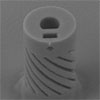| Apr 07, 2022 |
|
(Nanowerk News) A route for laser nano-printing of 3D crystalline structures was developed. The method employs ultrafast laser lithography, used as additive manufacturing tool for producing true 3D nanostructures, and combined with high temperature thermal post-treatment, converting the printed material into fully inorganic substance.
|
|
The carried out inter-disciplinary experimental work revealed potential of tuning the resulting ceramic structure into distinct crystalline phases, such as: cristobalite, SiO2, ZrSiO4, m-ZrO2, t-ZrO2. The proposed approach enabled achieving below 60 nm individual features dimensions without any beam shaping or complex exposure techniques, thus makes it reproducible with other established standard or custom made laser direct writing setups.
|
|
The principle is compatible with commercially available platforms (for instance: Nanoscribe, MultiPhoton Optics, Femtika, Workshop of Photonics, UpNano, MicroLight, and others). Figure 1 graphically summarizes the developed novel approach, involved procedure steps and resulting outcome.
|
 |
| Figure 1. A graphical summary showing: (a) used raw organic and inorganic precursors, their molar ratios in synthesis; (b) laser photopolymerization and high-temperature calcination technology; (c) formed crystalline phase nano-lattices after calcination (cristobalite, SiO2, zircon, monoclinic ZrO2 and tetragonal ZrO2); All of these phases can be observed and tuned depending on the treatment temperature and initial hybrid materials compositions. (Image courtesy of the researchers)
|
|
In brief, the validation of the combined laser manufacturing and thermal-treatment technique upgrades the widespread laser multi-photon lithography to a powerful tool enabling additive manufacturing of crystalline ceramics at an unprecedented precision and three-dimensional flexibility.
|
|
It is a milestone achievement in the ultrafast laser assisted processing of inorganic materials and sets a new high standard for the nanoscale laser 3D photopolymerization, which is no longer bounded to the limitation of just polymer or plastic materials.
|
|
While biologically derived and plant-based resins are extending applications in biomedicine and life sciences, the production of 3D inorganic nanostructures is opening new scientific technology-oriented research fields and enabling industry to acquire options for production of 3D nano-mechanics, nano-electronics, micro-optics and nano-photonics, enhanced telecommunication, and sensing chips. The achieved breakthrough is significantly contributing towards advancing the field of opto-electronics.
|
|
Dr. Darius Gailevičius with Prof. Mangirdas Malinauskas of Laser Nanophotonics Group (Laser Research Center, Physics Faculty, Vilnius University) proposed an approach for laser 3D additive manufacturing of nanoscale structures out of inorganic materials.
|
|
The laser printed objects were subsequently heat treated in order to completely remove the organic part of hybrid material, thus converting the substance into pure inorganic matter.
|
|
The aforementioned group members collaborating together with a material scientist Prof.Simas Šakirzanovas (Department of Applied Chemistry, Faculty of Chemistry and Geosciences, Vilnius University) anticipated the potential of sol-gel synthesis and chemical morphing of the substance into diverse and tunable phases by precisely controlling the initial ingredient ratio and the calcination processing protocol.
|
|
The main experimental work was performed by PhD student Greta Merkininkaitė with assistance of junior student Edvinas Aleksandravičius. A post-doc Dr. Darius Gailevičius has introduced essential conceptual insights and reviewed the experimental workflow.
|
 |
| Figure 2. A map of mesoscale 3D lithography or in other words true 3D printing – multiscale and multi-material is sketched. It covers dimensions from individual features below wavelength of VIS light (sub-diffraction) up to 3D objects above millimeters in sizes, while ensuring continuous scaling with no gaps or limitations in between. On the other angle of view, the materials are in full colors, thus resembling: biopolymers and proteins as natural and purely organic resins, hybrid materials offering glass-like properties or composites with enhanced specific functionalities, and finally inorganic substances such as ceramics or crystals – which are now made possible to realize. All of it can be realized via laser mesoscale 3D lithography and is a tool for applications in a) nanophotonics; b) micro-optics and precision prototyping in microfluidics and micromechanics; c) bio-scaffolds. (Image courtesy of the researchers)
|
|
The finding of the work (Opto-Electronic Advances, “Laser additive manufacturing of Si/ZrO2 tunable crystalline phase 3D nanostructures”) is important to a whole spectrum of scientific research and industrial fields. It extends the widespread established laser two-photon polymerization technology towards additive manufacturing tool of ceramic and crystalline structures at a sub-100 nm feature definition.
|
|
This makes the previous limitation of the employed organic or hybrid polymers obsolete. In turn, it enables production of inorganic and tunable crystalline phase 3D nanostructures which are outperforming the previously available options of material choices or limited structural (2D or 2.5D geometries) flexibility.
|
|
In other words, the optical 3D printing is now offering additive manufacturing of various crystals. The revealed principle is of great interest and advantageous in making three-dimensional nano-photonic, micro-optical, nano-mechanic, micro-fluidic, nano-electronic and bio-medical components. It upgrades the laser 3D nanoscale printer from black and white into a full color, as the colors are represented by specific material and its inherent properties.
|
|
In Figure 2 continuous scaling and material variations are visually projected. A novel option of true 3D printing inorganic materials is marked as a benchmarking milestone achievement – upgrading the existent laser 3D lithography to a new exploitation level.
|



